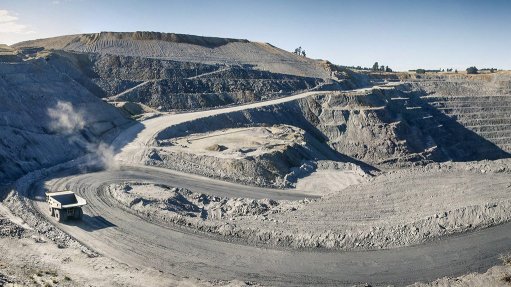
Name: Macraes mine.
Location: Macraes is located about 100 km north of Dunedin in the Otago region of the South Island, New Zealand.
Holding and Controlling Company: The project is controlled by OceanaGold Corporation through its wholly owned subsidiary OceanaGold (New Zealand) Limited.
Brief Description: The Macraes mine is New Zealand's largest gold mine.
Current operations comprise the Coronation and Frasers openpits, and Frasers underground mine. Mining at the Coronation North deposit started this year.
Brief History: The Macraes mine field was first mined for alluvial gold by individual prospectors in the 1850s and 1860s.
Alluvial mining by individual prospectors ended in 1875.
OceanaGold obtained 100% ownership of Macraes Mining Company (MMC) tenements in 1989 from Golden Point Mining and BHP Gold Mines (New Zealand).
Openpit mining started at the Macraes mine in 1990 and first gold was mined in November of the same year.
MMC was renamed Gold and Resource Developments (New Zealand) in 1999. In the same year, a pressure oxidation and autoclave facility was commissioned at Macraes, one of only three in the southern hemisphere.
In 2000, the company changed its name to GRD Macraes, which was changed again in 2004 to Oceana Gold (New Zealand) Limited.
Flotation cells were commissioned at Macraes in 2007 – the largest of this type operating in the world.
The Macraes openpit mine poured its two-millionth ounce of gold in 2005. Three years later the Frasers underground mine was commissioned.
The three-millionth ounce of gold was poured from the Macraes openpit in 2010.
Products: Gold.
Geology/Mineralisation: The Hyde Macraes Shear Zone (HMSZ), which hosts gold mineralization, is one of the largest Mesozoic structures mapped in the Otago schist, traceable for at least 30 km along strike.
The HMSZ is a mineralised schist up to 150 m thick, known as the Intrashear schist. The thickest part of the shear zone, which comprises several stacked mineralised zones, can be up to 25 m thick and is the most strongly mineralised structure.
The Macraes openpit and underground deposits are centred on the Hangingwall shear. The orebody dips at 150 to 200.
Gold is primarily associated with sulphides, and occurs principally as micoblebs within pyrite and arsenopyrite grains.
Reserves: Total proven and probable reserves for the Macraes openpit as at December 31, 2016, were estimated at 30.3-million tonnes, grading 1.10 g/t gold.
Total proven and probable reserves for Macraes underground as at December 31, 2016, were estimated at 1.85-million tonnes, grading 2.42 g/t.
Resources: Total measured and indicated resources for Macraes openpit as at December 31, 2016, were estimated at 82.5-million tonnes, grading 0.99 g/t gold.
Total measured and indicated resources for Macraes underground as at December 31, 2016, were estimated at 11.2-million tonnes, grading 2.42 g/t.
Total inferred resources for Macraes openpit as at December 31, 2016, were estimated at 39-million tonnes, grading 0.9 g/t gold.
Total inferred resources for Macraes underground as at December 31, 2016, were estimated at 3.5-million tonnes, grading 1.4 g/t gold.
Mining Method: Macraes is mined using a combination of conventional openpit and underground retreat uphole stope methods.
Major Infrastructure and Equipment: The Macraes project area contains the current openpit and underground mines, process plant, haulage roads, tailings storage areas and waste rock storage areas.
Macraes has sufficient surface project area for construction of any infrastructure necessary for the potential development and mining of other deposits under consideration.
Water is drawn from the Taieri river and pumped to the site.
Macraes is connected to the local power grid, which provides a reliable electrical power supply.
Prospects: Macraes’ goal is to continue to extend the life-of-mine with
value, and add targets, improve margins through technical studies and review all targets for viability.
Multiple targets along the HMSZ are being drilled to provide extensions for known mineralisation and improve confidence in the resource around Coronation North and Coronation. Infill drilling is being undertaken at Frasers West and drilling down plunge of Deepdell North and Golden Point has been proposed. Reconnaissance drilling of regional targets has been prioritised.
Contact: OceanaGold Corporation VP, investor relations Sam Pazuki and Jeffrey Sansom
Contact Details:
OceanaGold Corporation
Tel +1 604 235 3360 (Canada)
Tel +61 3 9656 5300 (Australia)
Email info@oceanagold.com
Website https://www.oceanagold.com